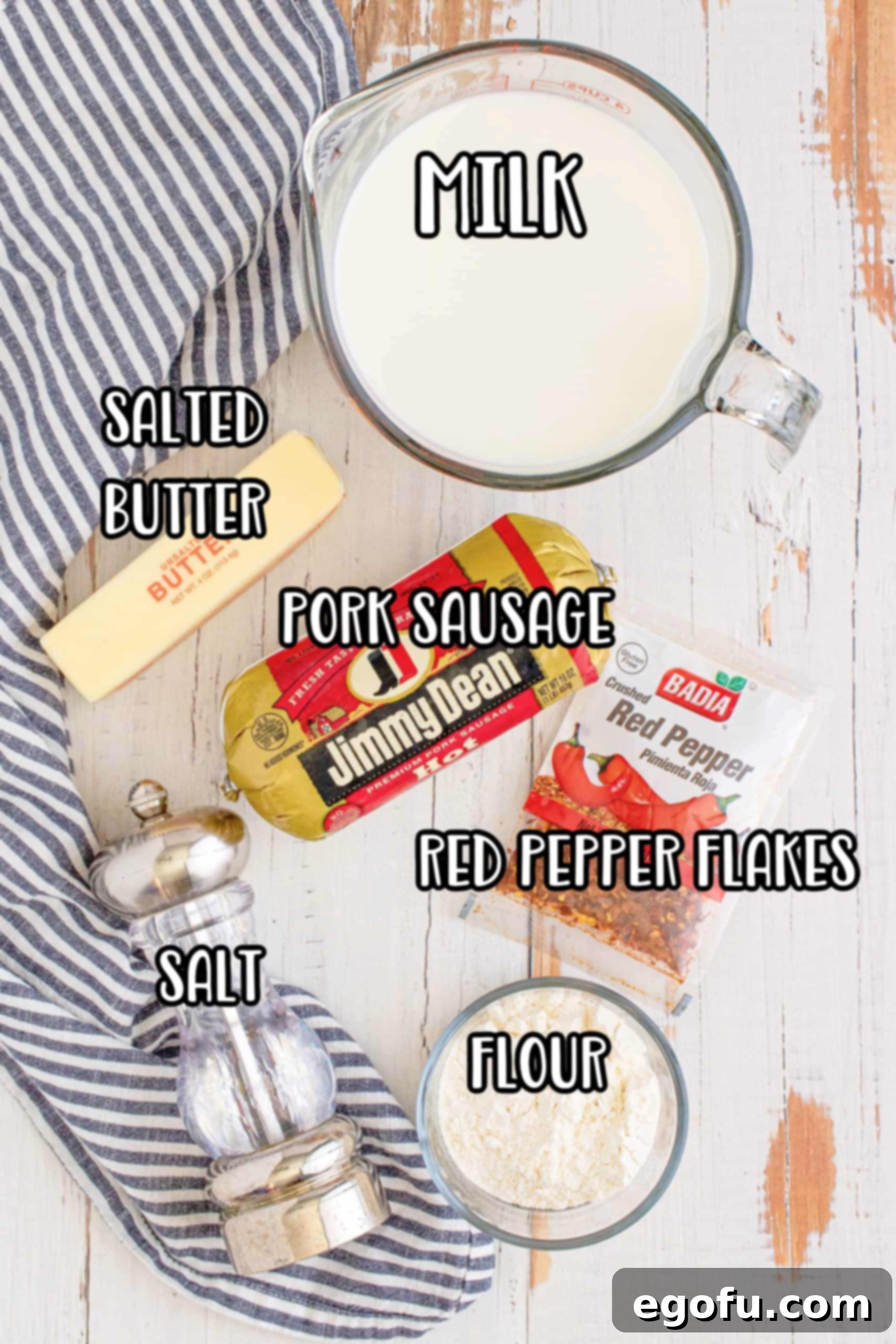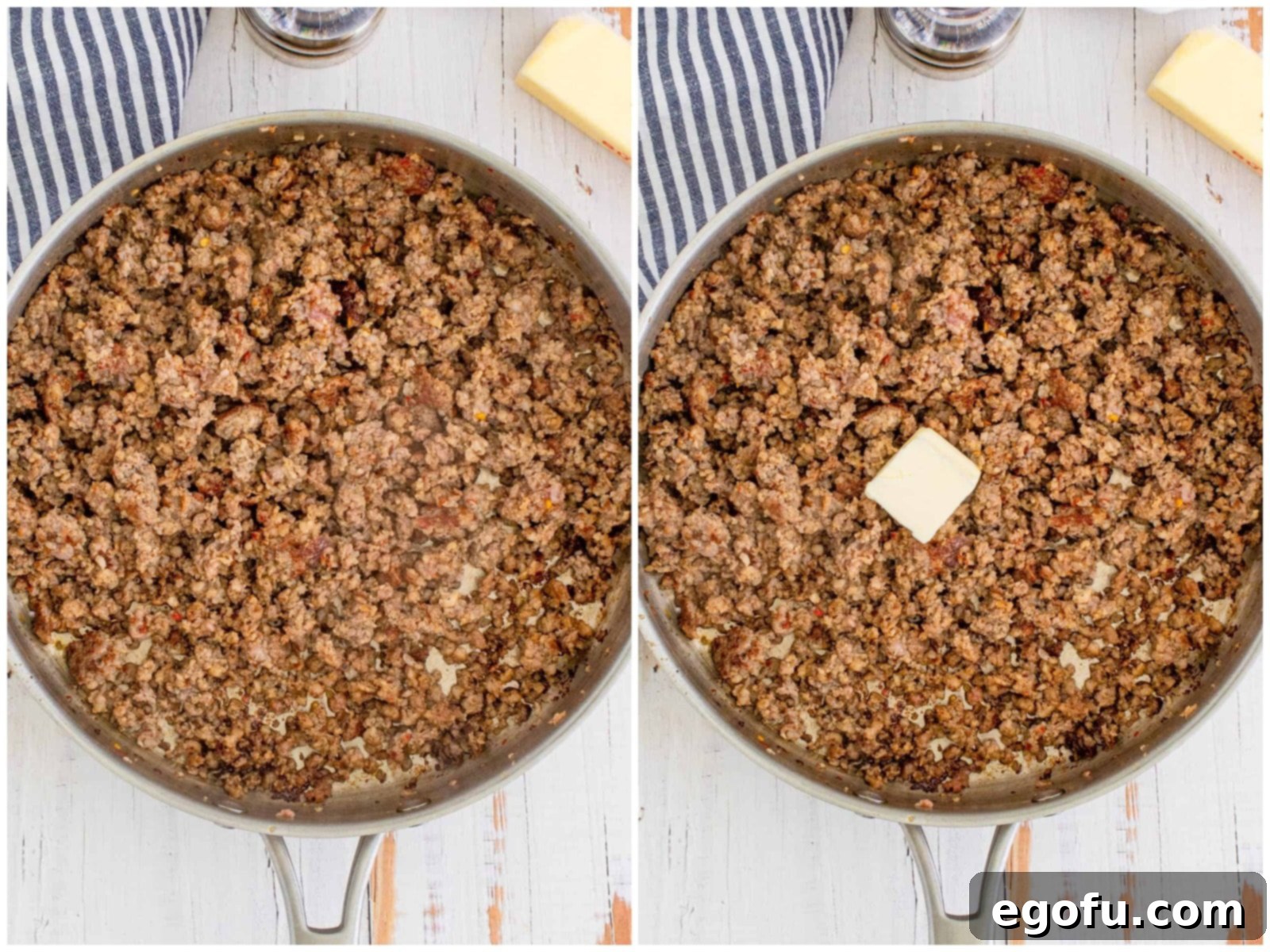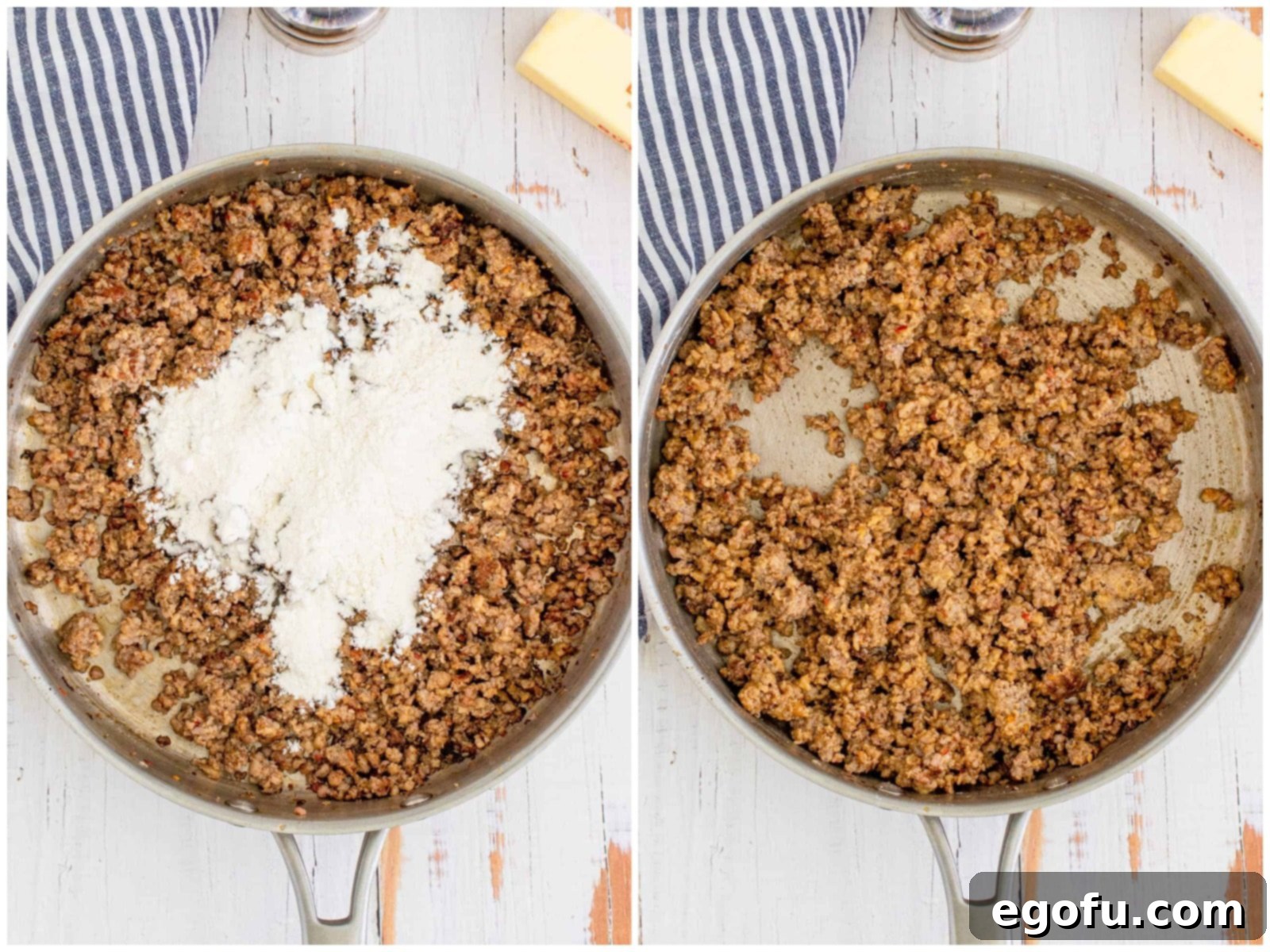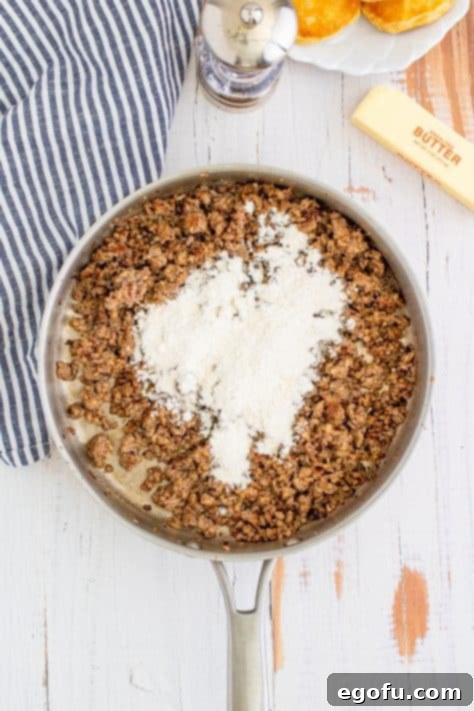Every cook yearns for that quintessential recipe that brings warmth and comfort to the breakfast table, and when it comes to classic American fare, Homemade Sausage Gravy stands unparalleled. This isn’t just any recipe; it’s the culmination of years of refinement, designed to deliver the most flavorful and creamy gravy you’ll ever spoon over your biscuits. With just a few simple ingredients and a dash of passion, you can transform your morning into a delightful culinary experience that will leave everyone craving another bite.
The Ultimate Homemade Sausage Gravy for Perfect Biscuits and Gravy
There’s nothing quite like a plate of warm, fluffy biscuits smothered in a rich, savory homemade sausage gravy to kickstart a leisurely weekend morning. This Homemade Sausage Gravy recipe is more than just a dish; it’s a testament to simple, hearty cooking that has been perfected over countless breakfasts. While it shines brightest when paired with golden, tender biscuits, its versatility extends far beyond, making it a beloved staple in any home kitchen. Whether you’re serving it as a cornerstone of a traditional Southern breakfast or seeking a comforting, filling meal for lunch or dinner, this gravy promises a culinary journey that will delight your taste buds and earn you rave reviews from family and friends.
This particular recipe has been meticulously crafted and refined over time to ensure absolute perfection. It’s the kind of gravy that tastes like home – rich, creamy, and bursting with the savory essence of well-seasoned sausage. Forget bland, watery gravies; this one is thick, luscious, and clings beautifully to every crevice of a biscuit. Get ready to impress, because once you master this recipe, requests for “more gravy, please!” will become a regular refrain at your table. Its simple yet profound flavor profile makes it an indispensable addition to any breakfast spread, providing that ultimate comfort food experience that truly nourishes the soul.

Frequently Asked Questions About Homemade Sausage Gravy
To help you achieve the perfect batch of Sausage Gravy every single time, we’ve compiled answers to some of the most common questions. These insights will guide you through ingredient choices, substitutions, and storage tips, ensuring your gravy is nothing short of spectacular and ready to become your go-to recipe.
Do I have to use hot pork sausage?
While I highly recommend using hot pork sausage for this homemade sausage gravy, it’s important to understand why and what alternatives you have. My preference for hot pork sausage stems from the subtle, underlying kick it provides. It’s not overpoweringly spicy – even for someone who typically avoids very hot foods – but rather introduces a depth of flavor that elevates the gravy beyond mere saltiness. This gentle warmth complements the richness of the milk and fat beautifully, creating a more complex and satisfying profile. I’ve experimented with sage sausage and mild regular sausage in the past, and while they yield a good gravy, they lack that distinctive “oomph” that the hot variety brings. However, if you’re truly averse to any heat, or if hot sausage is unavailable, feel free to substitute with your favorite ground sausage. Options include mild pork sausage, savory sage sausage for an herbier note, or even a homemade breakfast sausage blend. For a leaner option, such as ground turkey or chicken sausage, be mindful that these will render significantly less fat. Since the fat is crucial for building the roux that thickens the gravy, you might need to add an extra tablespoon of butter or a neutral oil (like vegetable or canola oil) to compensate and ensure your gravy achieves the desired consistency and richness.
What is a good biscuit recipe to serve with this classic sausage gravy?
The perfect biscuit is truly the ideal vessel for soaking up every drop of this creamy sausage gravy. The synergy between a flaky, tender biscuit and a rich, savory gravy is what defines a classic Southern breakfast. If time is of the essence, there’s absolutely no shame in using your favorite store-bought canned biscuits; many brands offer excellent flaky layer varieties that work wonderfully. However, if you’re embarking on the journey of homemade gravy, a homemade biscuit truly completes the experience and elevates the meal from good to unforgettable. For a truly authentic Southern breakfast, a traditional Southern Buttermilk Biscuit is my top recommendation. Their tangy flavor and tender, flaky texture are simply divine, providing a perfect counterpoint to the gravy’s richness. If you’re looking for an even simpler, no-fuss option that doesn’t require a biscuit cutter, my Butter Swim Biscuits (also known as Butter Dip Biscuits) are a revelation. They bake directly in a pool of butter, resulting in incredibly moist and rich biscuits with a crispy bottom, making them virtually foolproof. Whichever you choose, ensure they’re warm and fresh for the best possible pairing, allowing them to absorb all the delicious flavors of the gravy.
Can I substitute whole milk in this homemade sausage gravy recipe?
When it comes to homemade sausage gravy, whole milk is undeniably the star player in achieving that signature thick, rich, and creamy consistency. Its higher fat content (typically around 3.25% to 3.5%) is essential for creating a stable emulsion with the roux (the cooked mixture of flour and sausage fat) and contributing to the luxurious mouthfeel that is characteristic of classic Southern gravy. Skimping on milk fat can significantly impact the final texture, resulting in a thinner, less satisfying gravy that lacks the desired body and creaminess. While I strongly advocate for whole milk to achieve the best version of this recipe, I understand that sometimes substitutions are necessary. If you absolutely must, you can use 2% or even 1% milk, but be aware that the gravy will be noticeably thinner and less rich. Heavy cream or half-and-half can be used to add richness, but they might make the gravy too thick or change its traditional flavor profile if used exclusively. You may need to thin them with a bit of water or lower-fat milk. Avoid skim milk entirely, as its lack of fat will prevent proper thickening and result in a watery, disappointing gravy that won’t hold up. Remember, for the ultimate, most indulgent creamy sausage gravy, whole milk is your best friend.
How do I store and reheat leftover sausage gravy?
Proper storage ensures you can enjoy this delicious homemade sausage gravy for days to come, minimizing waste and maximizing your enjoyment. Once cooled completely to room temperature, transfer any leftover gravy to an airtight container. It will keep beautifully in the refrigerator for up to 5 days. Ensure it’s sealed well to prevent it from absorbing odors from other foods. For longer storage, gravy freezes remarkably well, making it perfect for meal prep or future cravings. Allow the gravy to cool entirely before transferring it to a freezer-safe container or a heavy-duty freezer bag. If using freezer bags, lay them flat on a baking sheet in the freezer until solid, then store them upright to save space; this also allows for quicker thawing. It can be stored in the freezer for up to 3 months without significant loss of quality. To reheat from frozen, it’s best to thaw it overnight in the refrigerator to ensure even reheating. Then, reheat slowly in a saucepan over low to medium-low heat, stirring frequently. Gravy tends to thicken upon cooling and reheating, so you might need to add a splash of milk or water (a tablespoon at a time) to reach your desired consistency. Avoid microwaving large quantities, as it can heat unevenly and affect the texture, leading to separation. Low and slow is the key to perfectly reheated Southern sausage gravy, bringing it back to its creamy, comforting best.

Essential Ingredients for the Best Creamy Sausage Gravy
Crafting exceptional homemade sausage gravy requires a careful selection of just a few high-quality ingredients. Each component plays a vital role in achieving that rich, creamy texture and unforgettable flavor. Below is a detailed look at what you’ll need, along with insights into why specific choices make all the difference and potential substitutions, ensuring you create the ultimate classic sausage gravy.
- Ground Hot Pork Sausage: This is the foundation of your gravy’s flavor profile. As discussed in the FAQs, the “hot” variety provides a nuanced, warming kick that elevates the dish without being overly spicy. Look for a good quality ground pork sausage, ideally one that renders enough fat for your roux. If unavailable or if you prefer a milder taste, substitute with mild pork sausage or even a sage-flavored breakfast sausage for a different aromatic profile. For a healthier twist, ground turkey or chicken sausage can be used, but you’ll likely need to supplement with extra butter or oil as leaner meats produce less fat essential for the roux.
- Unsalted Butter: Real butter is non-negotiable for superior flavor and texture in your breakfast gravy. It contributes significantly to the richness of the roux and adds a luxurious mouthfeel that margarine simply cannot replicate. Using unsalted butter allows you to control the overall saltiness of your gravy, which is particularly important since sausage can vary widely in its inherent salt content. If you only have salted butter, reduce the amount of added salt slightly and taste frequently.
- All-Purpose Flour: This is the essential thickening agent that creates the roux, forming the velvety base of your gravy. While I often gravitate towards brands like White Lily flour for its fine texture, any standard all-purpose flour will work perfectly. Since it’s used for thickening rather than baking, minor differences in protein content won’t significantly impact the outcome. It’s crucial for absorbing the fat and creating the smooth base. Avoid self-rising flour, as the leavening agents are not suitable for savory gravies. I haven’t experimented with gluten-free flour substitutes for this recipe, so proceed with caution if you choose to do so, as their thickening properties can differ.
- Whole Milk: As previously emphasized, whole milk is paramount for achieving the creamiest, thickest, and most flavorful gravy. Its fat content creates a stable emulsion with the roux and provides a rich body that lower-fat milks simply cannot match. The milk’s richness contributes significantly to the gravy’s overall mouthfeel and decadent taste. If you must substitute, 2% milk is a distant second, but expect a thinner gravy with less depth of flavor. Skim milk is not recommended for this recipe, as it will result in a thin, watery gravy that lacks the desired richness.
- Salt and Black Pepper: Proper seasoning is paramount in any gravy, and especially in this easy sausage gravy. I purposely don’t provide exact measurements for salt and pepper because personal preference varies widely, and the saltiness of your chosen sausage can differ significantly. Start with a moderate amount, then taste and adjust until it’s perfect for your palate. I tend to prefer a generous amount of fresh black pepper, which adds a lovely warmth and subtle spice that complements the sausage beautifully. Remember, you can always add more seasoning, but you can’t take it away! Seasoning in layers and tasting as you go is the secret to a perfectly balanced and delicious creamy sausage gravy.
- Red Pepper Flakes (Optional): For those who appreciate an extra layer of vibrant heat and visual appeal, a pinch of red pepper flakes is a wonderful addition. It provides a more direct, fiery spice than the hot sausage alone, creating a pleasant zing. If you love a spicier gravy, feel free to be generous; if you prefer it milder or are sensitive to heat, simply omit them. This is a customizable ingredient to suit your family’s preferences.
- Biscuits (for Serving): While technically not an ingredient for the gravy itself, fresh, warm biscuits are the essential accompaniment. They are the canvas for your culinary masterpiece. Whether homemade or store-bought, ensure they are ready to be drenched in your glorious sausage gravy as soon as it’s finished cooking. The combination of warm, soft biscuits and hot, creamy gravy is an iconic pairing.

How to Make the Best Homemade Sausage Gravy: A Step-by-Step Guide
Creating this rich and creamy sausage gravy is simpler than you might think. Follow these detailed steps to ensure a perfect, lump-free, and incredibly flavorful result every time. The key is to pay attention to the details and allow each stage to develop properly, building layers of flavor and achieving that coveted smooth consistency.
Brown the Sausage: Begin by placing a large skillet with deep sides over medium-high heat. Add your 1 pound ground hot pork sausage to the hot pan. Using a sturdy spoon or a meat chopper, brown and crumble the sausage thoroughly. Stir occasionally to ensure even cooking and prevent sticking to the bottom of the pan. Continue until all the sausage is cooked through and no pink remains, which usually takes about 5 minutes. This step is crucial for rendering out the delicious fat that forms the base of your roux. Do not drain the excess grease from the pan; it’s absolutely essential for the next step of creating the roux for gravy!

Step 1: Perfectly browned and crumbled sausage, retaining its flavorful grease. Melt the Butter: Once the sausage is fully cooked and the heat has been reduced, lower the heat to medium-low. Add 1 Tablespoon salted butter to the skillet with the sausage and its rendered fat. Stir continuously until the butter is completely melted and thoroughly combines with the sausage grease. This mixture of fat is what we call a roux base, and it’s what will provide the necessary fat to absorb the flour and thicken our gravy, ensuring a smooth, rich foundation.
Create the Roux: Now, evenly sprinkle the ⅓ cup all-purpose flour over the sausage and butter mixture in the skillet. Stir vigorously and constantly for about 30 seconds. It’s vital to ensure that the flour is fully absorbed by the fat, coating every bit of the sausage and forming a thick, uniform paste. This brief cooking time is essential, as it helps to cook out the raw flour taste, which is crucial for a smooth, palatable gravy that doesn’t have a powdery aftertaste.

Step 3: Flour perfectly incorporated into the sausage and fat, forming the roux. Slowly Add Milk and Thicken: This is perhaps the most critical step for preventing lumps and achieving a silky smooth gravy. Begin to very slowly stream in the 3 ½ cups whole milk while stirring constantly and vigorously with a whisk or sturdy spoon. The key here is patience; if you pour the milk in too fast, the flour can seize up and create stubborn lumps. Continue stirring until all the milk is incorporated and the gravy starts to smooth out. Increase the heat slightly to medium-low (if necessary) and continue to cook, stirring occasionally, until the gravy comes to a gentle simmer and noticeably thickens to your desired consistency. This usually takes between 3-5 minutes, as the flour fully activates and thickens the liquid. As it thickens, make sure to scrape the bottom and corners of the pan frequently, as the flour mixture can sometimes settle and stick there.

Step 4: Slowly adding milk while stirring to achieve a perfectly smooth, lump-free gravy. Ensure Smoothness: As the gravy simmers and thickens, pay close attention to the consistency. Make sure to scrape the bottom and corners of the pan thoroughly and frequently. This prevents any flour mixture from sticking or burning, ensuring a uniformly smooth and creamy gravy without any undesirable bits. If you notice any small lumps, continue whisking vigorously over the heat; they will often dissolve as the gravy heats through.
Season to Perfection: Once the gravy has reached your desired thickness, it’s time to season it to your liking. Add 1 teaspoon black pepper, salt, to taste and, if using, a pinch of red pepper flakes. Stir them in until well combined, ensuring the seasonings are evenly distributed throughout the gravy. Now, taste the gravy carefully. This is where you’ll add more salt, little by little, until it perfectly suits your taste buds. Remember that the sausage itself contributes salt, so always taste before adding too much. Adjust the seasonings as needed until you achieve a perfectly balanced and delicious creamy sausage gravy.

Step 6: Final seasoning and stirring. Serve Immediately: The moment it’s ready, serve your glorious homemade sausage gravy piping hot over your favorite warm biscuits. Don’t let it sit too long, as it will continue to thicken as it cools. The best experience comes from serving it fresh off the stove, allowing the warm, creamy gravy to melt into the tender biscuits. Get ready for a truly satisfying and memorable meal that will transport you straight to a Southern kitchen!

Step 7: Ready to serve!

Storing and Reheating Your Homemade Sausage Gravy
Making a generous batch of this delicious sausage gravy means you can enjoy its comforting flavors beyond just one meal. Knowing how to properly store and reheat it is key to preserving its taste and texture, ensuring it remains as delightful as when it was first made.
- Refrigerator Storage: Allow any leftover gravy to cool completely to room temperature before transferring it to an airtight container. Stored this way, it will remain fresh and delicious in the refrigerator for up to 5 days. Ensure the container is tightly sealed to prevent it from absorbing any odors from other foods in your fridge.
- Freezer Storage: For longer preservation, sausage gravy is surprisingly freezer-friendly. Once cooled, pour the gravy into a freezer-safe container or heavy-duty freezer bags. If using bags, lay them flat on a baking sheet in the freezer until solid, then store them upright to save space; this also allows for quicker and more even thawing. It will keep well for up to 3 months without significant loss of quality. Always label with the date for easy tracking.
- Reheating Instructions:
- From Refrigerator: Reheat slowly in a saucepan over low to medium-low heat, stirring frequently. Gravy naturally thickens as it cools, so if the gravy has become too thick, add a splash of milk or water (a tablespoon at a time) until it reaches your desired creamy consistency. Continue stirring until heated through.
- From Freezer: For best results, thaw frozen gravy overnight in the refrigerator. Once thawed, reheat using the same method as refrigerated gravy – slowly in a saucepan over low heat, adding liquid as needed to achieve the right consistency. Avoid high heat, which can cause the gravy to separate or scorch, ruining its smooth texture. Patience is key for a perfectly reheated, creamy gravy.
Beyond Biscuits: Versatile Ways to Enjoy Sausage Gravy
While biscuits are the undeniable classic pairing, this savory homemade sausage gravy is incredibly versatile! Don’t limit yourself to just breakfast; explore these delicious and creative ways to incorporate its comforting flavors into other meals throughout the day. It’s a fantastic way to elevate simple dishes and add a touch of Southern charm.
- Mashed Potatoes: Transform plain mashed potatoes into a hearty side dish or a comforting main course by generously spooning gravy over them. The rich, creamy gravy complements the fluffy potatoes perfectly.
- Eggs and Toast: For an extra-filling and flavorful breakfast, pour it over scrambled eggs or simple fried eggs with a side of crispy toast. It turns a basic meal into something special.
- Grits or Polenta: For a true Southern twist, serve the gravy over creamy grits or polenta. The combination of textures and flavors – the coarse cornmeal with the smooth, savory gravy – is exceptional and deeply satisfying.
- Home Fries or Hash Browns: Elevate your potato side dishes by drenching crispy home fries or hash browns in this rich gravy. It adds moisture and a burst of savory flavor to every bite.
- Open-Faced Sandwich: For a quick and satisfying lunch or dinner, serve it over thick slices of country bread or Texas toast, creating a comforting open-faced sandwich. You can even add a fried egg on top!
- Breakfast Burritos/Bowls: Use it as a rich, creamy sauce base for breakfast burritos or as a flavorful topping for breakfast bowls filled with eggs, roasted potatoes, cheese, and your favorite vegetables.
- Smothered Pork Chops or Chicken Fried Steak: This gravy isn’t just for breakfast! It makes an excellent accompaniment for smothered pork chops, chicken fried steak, or even pan-seared chicken breasts, turning them into a comforting, homestyle meal.
Craving More Comfort Food Recipes?
If you’ve fallen in love with the comforting, hearty flavors of this homemade sausage gravy, you’re in luck! There’s a whole world of delicious, family-favorite recipes waiting to be discovered that embody the same spirit of warmth and satisfaction. Expand your culinary repertoire with these mouth-watering and deeply satisfying dishes, perfect for any occasion:
- Biscuits and Gravy Casserole: All the goodness of biscuits and gravy transformed into a convenient, bakeable dish, perfect for feeding a crowd or for meal prepping.
- S.O.S. (Creamy Hamburger Gravy): A classic military-inspired dish, equally comforting and versatile, serving as a hearty meal over toast.
- Sausage, Egg and Cheese Biscuit Casserole: A complete breakfast solution baked in one dish, perfect for brunches or busy mornings.
- Biscuits and Gravy Bombs: Innovative, bite-sized pockets of savory delight, ideal for appetizers or a fun breakfast twist.
- The Best Breakfast Pizza: A fun and customizable way to enjoy breakfast flavors, piled high with eggs, cheese, and your favorite breakfast meats.
- Air Fryer Buttermilk Biscuits: Quick and easy biscuits with a perfect golden crust, ideal for serving alongside any gravy.
- Creamed Chipped Beef: Another classic creamy gravy dish, excellent over toast, reminiscent of old-fashioned comfort food.
- Country Ham with Red Eye Gravy: A distinct Southern favorite with a unique coffee-based gravy, offering a savory and slightly bitter complement to salty country ham.
- Sausage Gravy Butter Swim Biscuits: The ultimate combo of incredibly easy-to-make biscuits and this delicious sausage gravy, a match made in breakfast heaven.

Homemade Sausage Gravy
Every cook needs a good recipe for Homemade Sausage Gravy, and this is the one! With just a few ingredients and a little time, you can have the most flavorful and creamy gravy for your biscuits!
Rating: 5.0 out of 5 stars (Based on 29 reviews)
Print Recipe | Pin Recipe
Prep Time: 5 minutes
Cook Time: 15 minutes
Total Time: 20 minutes
Servings: 6
Author: Brandie Skibinski
Ingredients
- 1 pound ground hot pork sausage
- 1 Tablespoon salted butter
- ⅓ cup all-purpose flour (recommended: White Lily flour)
- 3 ½ cups whole milk
- 1 teaspoon black pepper (or to taste) (external link)
- Salt, to taste
- Pinch of red pepper flakes (optional)
- Biscuits (for serving)
Instructions
In a large skillet with deep sides, over medium-high heat, add 1 pound ground hot pork sausage. Brown and crumble the sausage, stirring occasionally until cooked through and there is no pink left, about 5 minutes. Do not drain the excess grease.

Step 1: Browning the sausage. Turn the heat to medium-low. Add 1 Tablespoon salted butter to the pan, stir it in to melt.

Step 2: Adding butter to the browned sausage. Add ⅓ cup all-purpose flour and stir it in so it gets fully absorbed in the fat and covers the sausage. Cook for 30 seconds, stirring constantly.

Step 3: Incorporating flour to create the roux. Very slowly stream in 3 ½ cups whole milk while stirring constantly. If you pour the milk in too fast it may form lumps. Continue to cook, stirring occasionally until it comes to a simmer and thickens, 3-5 minutes.

Step 4: Slowly whisking in the milk. Make sure to scrape the bottom and corners of the pan where the flour mixture may get stuck.
Season with 1 teaspoon black pepper, salt, to taste and a pinch of red pepper flakes (if using) and stir it in. Taste and adjust seasoning if necessary.

Step 6: Final seasoning and stirring. Serve over your favorite biscuits.

Step 7: Ready to serve!
Video
Notes
- Please refer to the Frequently Asked Questions (FAQs) and the detailed ingredient list above for possible substitutions, expert tips, and answers to common inquiries regarding this Sausage Gravy recipe.
Course: Breakfast
Cuisine: American
Nutrition
Calories: 359 kcal | Carbohydrates: 12g | Protein: 17g | Fat: 27g | Sodium: 542mg | Fiber: 1g | Sugar: 7g
Nutritional Disclaimer
“The Country Cook” is not a dietician or nutritionist, and any nutritional information shared is an estimate. If calorie count and other nutritional values are important to you, we recommend running the ingredients through whichever online nutritional calculator you prefer. Calories and other nutritional values can vary quite a bit depending on which brands were used.
Did you make this recipe?
Share it on Instagram @thecountrycook and mention us #thecountrycook!









